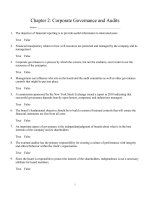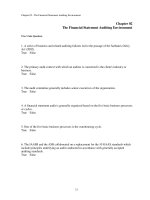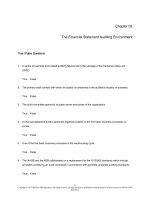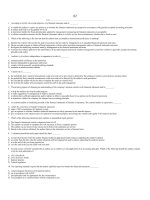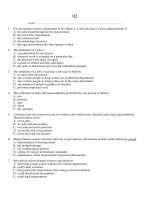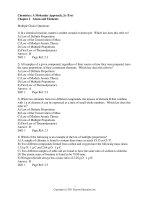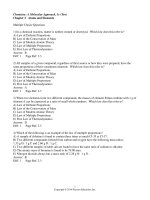Managing supply chains a logistics approach international edition 9th edition coyle test bank
Bạn đang xem bản rút gọn của tài liệu. Xem và tải ngay bản đầy đủ của tài liệu tại đây (226.35 KB, 9 trang )
Coyle Managing Supply Chains: A Logistics Approach, 9th Edition
Chapter 2 Test Bank
CHAPTER 2 TEST QUESTIONS
True-False
1. The utility created through the basic marketing activities is known as place utility.
ANSWER: False
2. Transportation is the physical movement or flow of goods.
ANSWER: True
3. During the 1990s and 2000s, logistics costs as a percentage of gross national product declined.
ANSWER: True
4. Logistics systems having a very heavy inbound flow and a very simple outbound flow are reverse
systems.
ANSWER: False
5. Acme Battery distributes its batteries to warehouses, where they are stored until ordered by a retailer.
The warehouses are located close by the retail markets served. This is the logistics channel approach to
logistics.
ANSWER: True
6. In a logistics system, warehousing should be optimized at the expense of related logistics activities,
such as transportation and procurement.
ANSWER: False
7. The mathematical calculation of the point of equality between systems under analysis is used for
short-run/static analysis.
ANSWER: False
8. To hold down distribution cost, the lowest cost carrier should always be used.
ANSWER: False
9. The inverse relationship that exists between the cost of lost sales and inventory costs is the inventory
effect.
ANSWER: True
2-1
© 2013 Cengage Learning. All Rights Reserved. This edition is intended for use outside of the U.S. only, with content that may be different
from the U.S. Edition. May not be scanned, copied, duplicated, or posted to a publicly accessible website, in whole or in part.
Coyle Managing Supply Chains: A Logistics Approach, 9th Edition
Chapter 2 Test Bank
Multiple Choice
10. Ensuring the availability of the right product, in the right quantity, and the right condition, at the right
place, at the right time, for the right customer at the right cost, is which definition of logistics?
a. Seven Rs
b. Council of Logistics Management
c. Society of Logistic Engineers
d. supply chain logistics
ANSWER: a
11. Logistics is the process of anticipating customer needs and wants; acquiring the capital, materials,
people, technologies, and information necessary to meet those needs and wants; optimizing the goodsor service-producing network to fulfill customer requests; and utilizing the network to fulfill customer
requests in a timely manner. This is a
a. definition from an inventory perspective.
b. general definition.
c. definition offered by the Society of Logistics Engineers.
d. a definition provided by the Council of Logistics Management.
ANSWER: b
12. All four subdivisions of logistics have some common characteristics. Which of the below does not
belong in the list:
a. transportation
b. marketing
c. scheduling
d. forecasting
ANSWER: b
13. The value that is added to a good through a manufacturing, production, or assembly process is:
a. form utility
b. place utility
c. time utility
d. possession utility
ANSWER: a
2-2
© 2013 Cengage Learning. All Rights Reserved. This edition is intended for use outside of the U.S. only, with content that may be different
from the U.S. Edition. May not be scanned, copied, duplicated, or posted to a publicly accessible website, in whole or in part.
Coyle Managing Supply Chains: A Logistics Approach, 9th Edition
Chapter 2 Test Bank
14. A product's form utility is created when value is added to the product through a manufacturing,
production or assembly process. However, logistics activity can provide form utility also. Which is an
example of the creation of form utility by a logistics activity?
a. when lumber is cut and made into a chair
b. when a firm's finance manager approves customer purchases on a credit basis
c. when bulk computer disks in different colors are packed in three-color assortments for sale
to computer users
d. the breaking bulk and repackaging at a distribution center
ANSWER: d
15. The utility that is created by moving goods from surplus points to points where demand exists is
referred to as:
a. form
b. place
c. time
d. possession
ANSWER: b
16. Which is created when a product or service is at a point when demanded by customers?
a. form utility
b. place utility
c. time utility
d. possession utility
ANSWER: b
17. Time utility depends on
a. when the carrier picks up the shipment.
b. transportation companies delivering on time.
c. proper forecasting.
d. having the product available when the user wants it.
ANSWER: d
18. What is often the largest component of logistics costs?
a. inventory costs
b. transportation costs
c. shipper-related costs
d. administrative costs
ANSWER: b
2-3
© 2013 Cengage Learning. All Rights Reserved. This edition is intended for use outside of the U.S. only, with content that may be different
from the U.S. Edition. May not be scanned, copied, duplicated, or posted to a publicly accessible website, in whole or in part.
Coyle Managing Supply Chains: A Logistics Approach, 9th Edition
Chapter 2 Test Bank
19. Materials handling is concerned with
a. inventory levels.
b. breaking bulk.
c. scheduling trade-offs.
d. short distance movement.
ANSWER: d
20. Marketers have begun to recognize the strategic value of place in the marketing mix, as well as the
benefits resulting from high-quality logistical services. As a result, which has been recognized as the
interface activity between marketing and logistics?
a. product
b. promotion
c. price
d. customer service
ANSWER: d
21. Celebrated Products is introducing a new line of celebrity signature sunglasses. The sales manager
wants a media blitz to make customers aware of the line and create early sales typical of a "pull"
pattern. Which will be a likely result of the marketing manager's plan?
a. a stable demand pattern
b. emergency shipments
c. an erratic demand pattern
d. strain on the logistics system
ANSWER: c
22. What activity is described as the movement of goods into a warehouse, the placement of goods in a
warehouse, and the movement of goods from storage to order picking areas and eventually to dock
areas for transportation out of the warehouse?
a. materials handling
b. physical distribution
c. business logistics
d. order fulfillment
ANSWER: a
23. A(n) ____ relationship exists between the cost of lost sales and inventory cost.
a. reverse
b. proportional
c. inverse
d. non linear
ANSWER: c
2-4
© 2013 Cengage Learning. All Rights Reserved. This edition is intended for use outside of the U.S. only, with content that may be different
from the U.S. Edition. May not be scanned, copied, duplicated, or posted to a publicly accessible website, in whole or in part.
Coyle Managing Supply Chains: A Logistics Approach, 9th Edition
Chapter 2 Test Bank
24.
Water Cruisers is located in Jacksonville, Florida, and makes small yachts and luxury pontoon boats
for customers on the East coast of the United States. Each boat requires thousands of parts purchased
from over 1,000 vendors. A number of boats are in production at any one time, so a large number of
parts constantly arrive and are stored. Once a boat is finished, it is sailed up the coast to a convenient
port for customer delivery. Which type of logistics system does Water Cruisers use?
a. balanced system
b. heavy inbound
c. heavy outbound
d. reverse system
ANSWER: b
25. A number of product-related factors affect the cost and importance of logistics. Which is not one of
these factors?
a. value
b. density
c. stock keeping units
d. risk of damage
ANSWER: c
26. When a specific point in time, or level of production, is chosen and costs are developed for the various
logistics cost centers, it is called
a. least cost analysis.
b. short run analysis.
c. cost center analysis.
d. link node analysis.
ANSWER: b
27. A ____ analysis examines a logistics system over a long time period or range of output.
a. cost center analysis
b. dynamic
c. link node analysis
d. least cost analysis
ANSWER: b
28. A balanced system is
a. one where all four management systems are equal
b. logistics expenses are equal to cost of goods sold
c. another name for supply chain management
d. inbound and outbound flows are nearly equal
ANSWER: d
29. What are established spatial points where goods stop for storage or processing?
a. nodes
b. links
2-5
© 2013 Cengage Learning. All Rights Reserved. This edition is intended for use outside of the U.S. only, with content that may be different
from the U.S. Edition. May not be scanned, copied, duplicated, or posted to a publicly accessible website, in whole or in part.
Coyle Managing Supply Chains: A Logistics Approach, 9th Edition
Chapter 2 Test Bank
c. cost centers
d. fulfillment centers
ANSWER: a
ESSAY
30. What is the primary challenge of logistics?
ANSWER:
The challenge is to manage the entire logistics system in such a way that order fulfillment meets and
perhaps exceeds customer expectations. At the same time, the competitive marketplace demands
efficiency--controlling transportation, inventory, and other logistics-related costs. Cost and service
tradeoffs have to be considered when evaluating customer service levels and the associated total cost
of logistics; but both goals--efficiency and effectiveness--are important to an organization in today's
competitive environment.
31. What is the definition of logistics which the authors choose and what group had formulated it?
ANSWER:
The definition offered by the Council of Supply Chain Management Professionals is: "The art and
science of management, engineering, and technical activities concerned with requirements, design, and
supplying and maintaining resources to support objectives, plans, and operations."
32. The text mentions four subdivisions of logistics. Pick one, define and discuss.
ANSWER:
Business logistics: That part of the supply chain process that plans, implements, and controls the
efficient, effective flow and storage of goods, service, and related information from point of use or
consumption in order to meet customer requirements.
Military logistics: The design and integration of all aspects of support for the operational capability
of the military forces (deployed or in garrison) and their equipment to ensure readiness, reliability, and
efficiency.
Event logistics: The network of activities, facilities, and personnel required to organize, schedule,
and deploy the resources for an event to take place and to efficiently withdraw after the event.
Service logistics: The acquisition, scheduling, and management of the facilities/assets, personnel,
and materials to support and sustain a service operation or business.
2-6
© 2013 Cengage Learning. All Rights Reserved. This edition is intended for use outside of the U.S. only, with content that may be different
from the U.S. Edition. May not be scanned, copied, duplicated, or posted to a publicly accessible website, in whole or in part.
Coyle Managing Supply Chains: A Logistics Approach, 9th Edition
Chapter 2 Test Bank
33. There are five principal types of economic utility that add value to a product or service. Name
four of the five and pick one to discuss in more detail.
ANSWER:
The five principal types of economic utility that add value to a product or service. Included are form,
time, place, quantity, and possession. Generally, production activities are credited with providing form
utility; logistics activities with time, place, and quantity utilities; and marketing activities with
possession utility.
34. The logistics definitions discussed indicate 14 activities for which the logistics manager might be
responsible. Name at least eight and briefly discuss any two in detail.
ANSWER:
Transportation
Warehousing and storage
Industrial packaging
Materials handling
Inventory control
Order fulfillment
Demand forecasting
Production planning/scheduling
Procurement
Customer service
Facility location
Return goods handling
Parts and service support
Salvage and scrap disposal
35. Another dimension of logistics is the micro perspective which examines the relationships
between logistics and other functional areas in an organization. What are these other functions?
Select one and discuss how it interacts with logistics.
ANSWER:
Another dimension of logistics is the micro-perspective, which examines the relationships between
logistics and other functional areas in an organization--marketing, manufacturing/operations, finance
and accounting, and others. Logistics, by its nature, focuses on processes that cut across traditional
functional boundaries, particularly in today's environment with its emphasis on the supply chain.
Consequently, logistics interfaces in many important ways with other functional areas.
2-7
© 2013 Cengage Learning. All Rights Reserved. This edition is intended for use outside of the U.S. only, with content that may be different
from the U.S. Edition. May not be scanned, copied, duplicated, or posted to a publicly accessible website, in whole or in part.
Coyle Managing Supply Chains: A Logistics Approach, 9th Edition
Chapter 2 Test Bank
36. What are the 4 "PHs"? Select one, and discuss how it affects logistics.
ANSWER:
Logistics is sometimes referred to as the other half of marketing. The rationale for this definition is
that the physical distribution or outbound side of an organization's logistics system is responsible for
the physical movement and storage of products for customers and thus plays an important role in
selling a product. In some instances, physical distribution and order fulfillment might be the key
variables in selling a product; that is, the ability to provide the product at the right time to the right
place in the right quantities might be the critical element in making a sale.
This section briefly discusses the interfaces between logistics and marketing activities in each principal
area of the marketing mix. The material is organized according to the four Ps of marketing--price,
product, promotion, and place. In addition, recent trends in the interface between logistics and
marketing will be discussed.
37. What is ROA? Discuss how it can impact logistics.
ANSWER:
While manufacturing and marketing are probably the two most important internal, functional
interfaces for logistics in a product-oriented organization, there are other important interfaces. The
finance area has become increasingly important during the last decade. The impact that logistics can
have upon return on assets (ROA) or return on investment (ROI) is very significant. ROA is defined as
follows:
ROA = Revenue Expenses/Assets
Or
ROA = Gross Profit/Assets
Logistics can positively impact ROA in several ways. First, inventory is both an asset on the balance
sheet and an expense on the income statement. Reducing inventory levels reduces the asset base as
well as the corresponding variable expenses, thus having a positive impact on ROA. Second,
transportation and warehousing costs can also influence ROA. If an organization owns its warehouses
and transportation fleet, assets will be increased. If these assets are reduced or eliminated, ROA will
increase. Similarly, if an organization utilizes third parties for warehousing and transportation, variable
expenses will be incurred. Reducing these expenses will also have a positive impact on ROA. Finally,
the focus on customer service can increase revenue. As long as the incremental increase in revenue is
larger than the incremental increase in the cost of customer service, ROA will increase.
2-8
© 2013 Cengage Learning. All Rights Reserved. This edition is intended for use outside of the U.S. only, with content that may be different
from the U.S. Edition. May not be scanned, copied, duplicated, or posted to a publicly accessible website, in whole or in part.
Coyle Managing Supply Chains: A Logistics Approach, 9th Edition
Chapter 2 Test Bank
38. There are a number of product-related factors that can affect the cost and importance of
logistics. Identify the factors, and pick one to discuss further.
ANSWER:
A number of product-related factors affect the cost and importance of logistics. Among the more
significant of these are dollar value, density, susceptibility to damage, and the need for special
handling.
39. Spatial relationship is extremely significant to logistics. Discuss why this is true.
ANSWER:
A final topic that is extremely significant to logistics is spatial relationships, the location of fixed
points in the logistics system with respect to demand and supply points. Spatial relationships are very
important to transportation costs, since these costs tend to increase with distance.
2-9
© 2013 Cengage Learning. All Rights Reserved. This edition is intended for use outside of the U.S. only, with content that may be different
from the U.S. Edition. May not be scanned, copied, duplicated, or posted to a publicly accessible website, in whole or in part.
